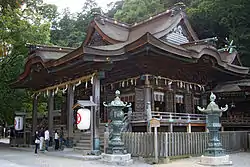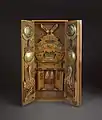Kotohira-gū
Kotohira-gū (金刀比羅宮) (also known as Konpira-dai-gongen (金比羅大権現), Konpira-san (こんぴらさん), or Konpira Shrine in English) is a Shinto shrine in the town of Kotohira in Kagawa, Japan. This shrine is patron of sea ship transport and sailors.
| Kotohira-gū (金刀比羅宮) | |
|---|---|
 Haiden of main shrine (本宮 hon-gū), Kotohira Shrine | |
| Religion | |
| Affiliation | Shinto |
| Location | |
 Shown within Japan | |
| Geographic coordinates | 34°11′03″N 133°48′35″E |
It is a Kotohira Shrine or one dedicated to Ōmononushi
Located at 521 metres (1,709 ft) halfway to the top of Mount Zōzu, the shrine stands at the end of a long path, with 785 steps to the main shrine and a total of 1368 steps to the inner shrine. Since the Muromachi period, pilgrimages to the shrine became popular, and even today usually hundreds of visitors in a day climb the steps of Mount Zōzu. On the way to the shrine is a sake museum, stores, and stones with the names of donors carved in kanji.
Before the Meiji era, Kotohira Shrine was also a Buddhist site as well (see honji suijaku).
History
It is said to have been founded during the 1st century.
The principal kami of the shrine is Ō-mono-nushi-no-mikoto, a spirit associated with seafaring (also referred to as the Buddhist deity Konpira). In 1165 the spirit of Emperor Sutoku was also enshrined.
Before the Meiji era it was known as Konpira-Daigongen (金比羅大権現), and it stood at the head of the nationwide group of shrines bearing the names Kompira and Kotohira. The ema hall is the site of prayers for safe seafaring. The Konpira temple was transformed into a Shinto shrine and renamed Kotohira in 1889.[1]
From 1871 through 1946, Kotohira was officially designated one of the kokuhei-chūsha (国幣中社), meaning that it stood in the mid-range of ranked, nationally significant shrines.
On June 5, 2020, Kotohira Shrine sent a notice to the Association of Shinto Shrines stating that it would abolish its inclusive relationship, due to the fact that the heihaku to be delivered on the day of the Daijō-sai accompanying the enthronement of the Emperor in the first year of Reiwa (2019) was not sent. In November 2020, the withdrawal from the Association was approved and became a standalone shrine.[2]
Treasures
Kompira Shrine has several Important Cultural Properties, including a Heian period statue of the eleven-faced Kannon Bosatsu and four ink paintings by Maruyama Ōkyo.
Gallery
 Hongū (main shrine) complex
Hongū (main shrine) complex Honden of the hongū
Honden of the hongū Mihotsu Jinja's haiden of the hongū
Mihotsu Jinja's haiden of the hongū Kaguraden of the hongū
Kaguraden of the hongū Asahi-sha
Asahi-sha Homotsukan museum
Homotsukan museum Kompira Shrine Votive Box, c. 1800–1894, from the Oxford College Archives of Emory University
Kompira Shrine Votive Box, c. 1800–1894, from the Oxford College Archives of Emory University
Notes
- Faure, Bernard (2021-12-31). Rage and Ravage: Gods of Medieval Japan, Volume 3. University of Hawaii Press. p. 437. ISBN 978-0-8248-8936-4.
- "神社本庁激震!"こんぴらさん"が離脱、「本庁は天皇陛下に不敬極まる」". ダイヤモンド・オンライン(ダイヤモンド社). June 6, 2020. Retrieved November 28, 2022.
External links
- Kotohira-gū official website (in Japanese)
- Guide to Kotohira-gū on Japan-guide.com (in English)
- 1179961756 Kotohira-gū on OpenStreetMap